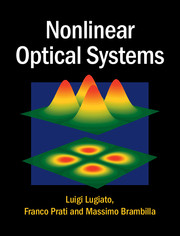Book contents
- Frontmatter
- Dedication
- Contents
- Preface
- Part I Models, propagation, stationary phenomena
- 1 The rate-equation model for the laser
- 2 The interaction of a system of two-level atoms with the electromagnetic field
- 3 The Maxwell–Bloch equations
- 4 Inclusion of the irreversible processes in the atomic equations
- 5 Propagation in irreversible Maxwell–Bloch equations
- 6 Optical nonlinearities. Materials with quadratic nonlinearities
- 7 Optical nonlinearities. Materials with cubic nonlinearities
- 8 Optical resonators. The planar ring cavity. Empty cavity. Linear cavity
- 9 A nonlinear active ring cavity: the ring laser, stationary states
- 10 The adiabatic elimination principle
- 11 A nonlinear passive ring cavity: optical bistability
- 12 Modal equations for the ring cavity. The single-mode model
- 13 Single- and two-mode models
- 14 Nonlinear dynamics in Fabry–Perot cavities
- 15 Inhomogeneous broadening
- 16 The semiconductor laser
- 17 Lasers without inversion and the effects of atomic coherence
- Part II Dynamical Phenomena, Instabilities, Chaos
- Part III Transverse optical patterns
- Appendix A The Routh–Hurwitz stability criterion
- Appendix B Calculation of the oscillatory instability boundary
- Appendix C Coefficients of the characteristic equation (20.20)
- Appendix D Derivation of equations (20.27) and (20.28)
- Appendix E Coefficients of equations (20.60) and (20.61)
- Appendix F The exact boundary of the Risken–Nummedal–Graham–Haken instability
- Appendix G Nonlinear analysis of the roll solution
- References
- Index
8 - Optical resonators. The planar ring cavity. Empty cavity. Linear cavity
from Part I - Models, propagation, stationary phenomena
Published online by Cambridge University Press: 05 March 2015
- Frontmatter
- Dedication
- Contents
- Preface
- Part I Models, propagation, stationary phenomena
- 1 The rate-equation model for the laser
- 2 The interaction of a system of two-level atoms with the electromagnetic field
- 3 The Maxwell–Bloch equations
- 4 Inclusion of the irreversible processes in the atomic equations
- 5 Propagation in irreversible Maxwell–Bloch equations
- 6 Optical nonlinearities. Materials with quadratic nonlinearities
- 7 Optical nonlinearities. Materials with cubic nonlinearities
- 8 Optical resonators. The planar ring cavity. Empty cavity. Linear cavity
- 9 A nonlinear active ring cavity: the ring laser, stationary states
- 10 The adiabatic elimination principle
- 11 A nonlinear passive ring cavity: optical bistability
- 12 Modal equations for the ring cavity. The single-mode model
- 13 Single- and two-mode models
- 14 Nonlinear dynamics in Fabry–Perot cavities
- 15 Inhomogeneous broadening
- 16 The semiconductor laser
- 17 Lasers without inversion and the effects of atomic coherence
- Part II Dynamical Phenomena, Instabilities, Chaos
- Part III Transverse optical patterns
- Appendix A The Routh–Hurwitz stability criterion
- Appendix B Calculation of the oscillatory instability boundary
- Appendix C Coefficients of the characteristic equation (20.20)
- Appendix D Derivation of equations (20.27) and (20.28)
- Appendix E Coefficients of equations (20.60) and (20.61)
- Appendix F The exact boundary of the Risken–Nummedal–Graham–Haken instability
- Appendix G Nonlinear analysis of the roll solution
- References
- Index
Summary
With the exception of Chapter 1, up to this point we have considered cavityless optical systems. With this chapter, instead, we start focussing on the case that the atomic medium is located in an optical cavity. We describe in detail the case of a unidirectional ring resonator, the boundary condition which characterizes it and the relations between its output fields and the intracavity field (Sections 8.1–8.3). We discuss the transmission of an empty cavity (Section 8.4) and of a cavity that contains a linear medium (Section 8.5).
Optical cavities
An optical cavity or optical resonator is formed by at least two mirrors, appropriately arranged in such a way that the radiation beam follows a closed path. The beam splitters allow the radiation to escape from the cavity (output) and allow one to inject radiation into the cavity (input). In order to confine the radiation transversally with respect to the direction of propagation, the mirrors are usually spherical (see Fig. 1.2). The case of cavities with spherical mirrors will be described in Part III of this volume. On the other hand, an analytical treatment of the problems is possible only within the plane-wave approximation which we will use in the remainder of Part I and in Part II. In accord with this, we assume here that the mirrors are planar.
The two most common types of optical resonator are the Fabry–Perot cavity and the ring cavity. The planar Fabry–Perot cavity consists in two beam splitters in a parallel configuration as shown in Fig. 8.1. Within the cavity there are two counterpropagating fields, EF propagating in the forward direction and EB propagating in the backward direction with respect to the input field EI. Because we have derived the Maxwell–Bloch equations for the unidirectional configuration, in this and the following chapters we focus on the case of a ring cavity, which allows unidirectionality. The Fabry–Perot case will be considered in Chapter 14.
- Type
- Chapter
- Information
- Nonlinear Optical Systems , pp. 85 - 94Publisher: Cambridge University PressPrint publication year: 2015



